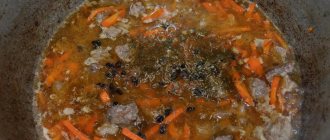OUTSTANDING WORKS OF CHEFS OF THE 19TH CENTURY
Many French chefs and pastry chefs, whose names have been preserved in human history to this day, had multifaceted talent and were famous travelers, lawyers, inventors and restaurateurs of their time.
The combination of such versatile qualities sometimes allowed them to create brilliant works that influenced the culture of gastronomy around the world. The variety of forms of these works is simply amazing... The ARToteka website has already talked about a unique guide for Parisians called “Gourmet Almanac”. It was compiled 200 years ago by the French lawyer, journalist and theater critic Alexandre Grimaud de La Reniere (1758–1838) . The pages of this gastronomic guide give us the opportunity to look through the eyes of an informed and witty eyewitness at how provisions were bought, prepared and served in Paris at the beginning of the 19th century. But during the same historical period, other, no less outstanding works were published, written by the great chefs of the early 19th century.
“The art of long-term preservation of all substances of animal and plant origin” (1810).
Nicolas Francois Appert (1749-1841) - French inventor of canned food. (In 2020, Upper's invention turned 207 years old.) Being the son of an innkeeper, Nicolas worked in the kitchen since childhood, where he later took the place of cook. Having realized the importance of long-term storage of products, he experimented with traditional methods of storing them - drying, pickling and salting. But as a result, he discovered that after prolonged heating, food can be stored for a long time in airtight packaging. (Which was 50 years ahead of Pasteur's discovery of the harmful effects of bacteria). In 1810, his essay “The Art of Preserving All Substances of Animal and Plant Origin” appeared in print. For his invention, the author personally received a state prize of 12,0000 francs and the title “Benefactor of Humanity” from the hands of Napoleon Bonaparte.
The enterprising inventor opened his own store, selling food supplies in hermetically sealed glass bottles, and, since 1814, in sealed tin cans. With him, he organized a mini-canning workshop, the first customer of which was the French War Ministry. Subsequently, the family enterprise grew into a large manufacturing business.
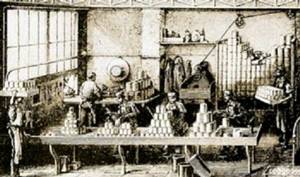
early 19th century canning shop
Now more than 60 streets in French cities are named after Nicolas Francois Appert, and in Chalons-en-Champagne there is a museum dedicated to the inventor of conservation.
*****
"The Art of the Cook" (1814).
Antoine Beauvilliers (1754-1817) - French chef and restaurateur. (His full biography and portrait have not survived). He began his career as the personal chef of the Count of Provence (the future King Louis XVIII). This is obviously where the tradition in his restaurants came from - to receive customers in embroidered uniforms and with a sword at their side.
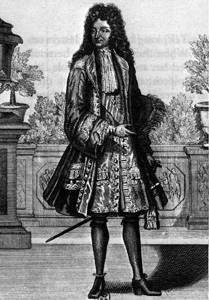
In the first Parisian luxury grand restaurant he opened in 1782, the same regal style and ambience have been preserved: mahogany tables, crystal chandeliers on the ceiling, tablecloths with gold monograms of damask patterns. Wine was served in bottles in the latest London fashion, and customers were promised a meal “like at Versailles.”
But the main advantage - in the words of the famous gastronomic chronicler and regular of this restaurant, Jean Anthelme Brillat-Savarin - was that the restaurant combined four pillars: an elegant interior, courteous and well-trained waiters, its own wine cellar and excellent cuisine.
The success of the Great London Tavern restaurant was so great that Beauvillier opened another one, which he already called by his own name - Beauvilliers.
In 1814, Beauvillier published the book “The Art of Cooking” (L`Art de cuisinier), which deals not only with various issues of cooking, but also with all other aspects of public catering. After the death of the author, the book for a long time remained the most popular - in modern terms - in the field of organizing restaurant management.
a school of culinary arts in Paris (in 1891). It had two sections - men's and women's. Women were trained free of charge in the intricacies of housekeeping. While training for men was paid. At school they studied the intricacies of professional cooking, accounting, the history of culinary art, and even the basics of such sciences as biology, drawing and others.
*****
"Universal Dictionary of Practical Kitchen" (1883-1889)
After the film “Julie and Julia: Cooking a Happiness Recipe,” it may seem that popular blogger Julie Powell invented the public form of a culinary diary. In fact, the first article of this kind was published in a Geneva newspaper back in 1877. Its author was the Swiss-born chef Joseph Favre (1849-1903). He called his diary “Culinary Science.”
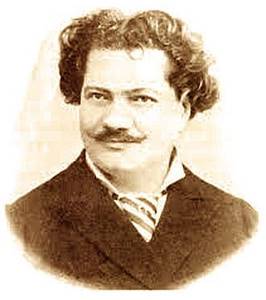
Favre's articles attracted attention throughout the culinary world. Which allowed him to create a “universal union for the progress of culinary art” in March 1879. As many as 80 branches of the union were formed around the world. While visiting them, Favre more than once acted as organizer of international culinary competitions. Along with Grimaud de La Renière and Baron Brisset, he became one of the leading food critics of the early 19th century.
But above all, Joseph Favre is known as a researcher and culinary technologist, as an educator in this area. The result of his 20 years of research was the 4-volume edition of the “Universal Dictionary of Practical Kitchen” (which, as we have already said, began with newspaper publications of his diary). During the period of preparation of the Dictionary, Favre still managed to publish “ The Illustrated Encyclopedia of Food Hygiene: Human Modification of Diet .”
The author initially paid special attention to hygiene and proper preparation of food - what is now called “healthy eating”. He believed in the healing properties of plants, being convinced that a healthy diet would eliminate the need for doctors. By compiling his “dictionary”, the author wanted to convey knowledge about food and gastronomy to families of any class. In his address to the reader, he has the following lines: “the mother of a family or housewife can now learn the important rules of food hygiene and give children food appropriate to the different stages of their early life.”
(Previously, such an attitude towards food was advocated by a famous Parisian broth merchant named Boulanger . Above the entrance of his establishment there was a sign with an inscription in Latin that read: “Come to me, all you who suffer from the stomach, and I will restore you”).
Joseph Favre's gourmandism also has its own clear boundaries:
There is a gulf between the values of Roman gluttony and culinary science. The first requires an emetic in order to again and again enjoy the greedy absorption of food, subsequently getting indigestion and gout. And the second is to strive for health, supports potency, the fruitful development of vital forces and contains intellectual abilities in their integrity...”
"The Universal Dictionary of Cuisine and Food Hygiene: Changing Man through Feeding," Joseph Favre.
*****
"The Physiology of Taste or Reflections on Gastronomy" (1825).
It is difficult to imagine a more diversified personality than Jean Anthelme At one time, this Frenchman was known as a philosopher, cook, lawyer, economist, politician and musician. He was a member of several literary and scientific communities and became famous for his book “ Physiology of Taste ,” in which he successfully combined culinary and literary arts. His work is filled with witty expressions that have become popular aphorisms and sayings like: “Tell me what you eat, and I will tell you what you are,” “A dessert without cheese is like a beauty without an eye,” and hundreds of other similar ones.
Savarin's work is decorated with many interesting historical facts, and the pages themselves often look like odes of praise, glorifying gastronomy - “the science that supports us from the cradle to the grave...”.
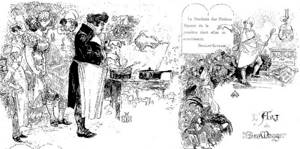
Friendly caricatures of Jean Anthelme Brillat-Savarin performed by the French caricaturist, illustrator and writer Albert Robide (1848 -1926).
It is no coincidence that the author believed that ““The discovery of a new dish is more important for human happiness than the discovery of a new luminary” and “Since we are condemned to eat, we will eat with taste.” In addition, the book contains hundreds of really valuable cooking tips and many reflections on the culture of “healthy food”. So, it is not without reason that “The Physiology of Taste” is called the “ bible of gastronomy ”.
Due to Brillat-Savarin’s active political activities, fate more than once forced him to go into hiding, change countries and types of occupation: Switzerland, Holland, Germany and even the USA, where for some time he performed the part of the first violin in the New York “Park Theater”. But wherever Savarin found himself, he remained a true epicurean, and devoted all his free time to collecting and analyzing information about gastronomy.
In accordance with these views, the author compiled his treatise “ Physiology of Taste, or Transcendental Cooking; a theoretical, historical and thematic work devoted to the gastronomy of Paris ." This comprehensive work by Jean Anthelme Brillat-Savarin, published in France three months before the author’s death, remained a reference book for every self-respecting cook for a whole century.
*****
"The Parisian Cook, or the Art of Cookery of the 19th Century", (1833)
Marie-Antoine Carême (1784 - 1833) was the most famous French chef of the early 19th century. It is surprising that the biography of such an outstanding personality is based on his own words. More precisely, on the information that he considered necessary to provide.
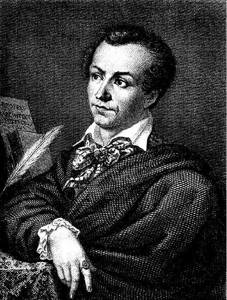
This chef is recognized throughout the world as an outstanding figure in the history of haute cuisine. He perceived his profession as nothing more than a union of a cook, a scientist and an artist. In cooking he adhered to the principles of delicate luxury and refined sensuality. He served as a cook at the courts of the highest persons and in fashionable establishments around the world.
But, contrary to popular belief, Karem’s merit lies not so much in the creation of new, original dishes, but in an attempt to provide a scientific basis for cooking. Here he undoubtedly continued the work of Brillat-Savarin, although he enriched Savarin’s somewhat amateurish view with the practical skills of a professional cook.
The talented nugget became the author of several well-known cookbooks. The history of cooking described in them is a real hymn to the profession: “At all times,” he writes, “there were people who were quite disinterested in order to sacrifice everything for the development of art and craft...”
A special advantage of his books was the careful codification (description) of many culinary technologies, the creation of a system of sauces, soups, meat, fish and vegetable dishes. In essence, it was about developing unified techniques for processing food and serving dishes that were understandable to every cook in any country.
In these writings, culinary operations are based on chemical analysis and rigorous calculations; cutting of meat is explained by drawings; some quarter of veal is depicted in three projections with the accuracy of an anatomical drawing; nothing is forgotten: from a learned treatise on how to make a deft cut between the ribs of a dark-brown Apis, to instructions on how to glue innocent cardboard boxes for a boule de gomme or cut out lace from paper to decorate a planted dish with fish.”
As a cook, Karême gravitated towards culinary luxury, however, he can be considered a man who wanted to make cooking more democratic. His books are focused not only on aristocratic cuisine, but also on the cuisine of the bourgeoisie. And in his book “ The Art of French Cuisine of the 19th Century ,” he expressed the dream that every citizen of France would have access to delicious food. The brilliant chef died at the age of 49, but remained in the memory of descendants as “the cook of kings and the king of cooks.”
*****
"Culinary Guide"
Georges Auguste Escoffier (French: Georges Auguste Escoffier; 1846 -1935) - French restaurateur, culinary critic and popularizer of traditional French cuisine. He developed and modernized the ideas of “haute cuisine” (French haute cuisine) of Marie-Antoine Carême and, after him, was awarded the title “King of Chefs.”
The story of his development began in the same way as that of the brilliant violinist Niccolo Paganini, whose father forced him to play the violin for many hours in a row from an early age. Escoffier's fate was also influenced by his father. Since school, Auguste dreamed of a career as an artist or sculptor, but by his father’s decision he became a cook. At the age of 13, he began working as a cook in his uncle's restaurant in Nice. This was the beginning of an incredible career that the boy himself did not suspect. During his life, he was the chef of the most famous restaurants - Le Petit Moulin Rouge in Paris, the Grand Hotel in Monte Carlo, and, since 1890, at the famous London Savoy Hotel.
The creation of signature dishes that made him famous throughout the world did not stop Escoffier from studying culinary theory and expanding her library with his works. His book “ The Culinary Guide ” (Le Guide Culinaire) is still popular both as a collection of recipes and as a textbook on culinary art. This is a true bible of French cooking, which contains several thousand recipes that served as the foundation for modern European cuisine.
Escoffier's work is paradoxical, like all things of genius. It combines scale and scrupulous attitude, naivety and academicism, exoticism and tradition. It was precisely such an author, especially a Frenchman, who could create famous dessert recipes in honor of the brilliant ladies of the century: the outstanding actress of the time Sarah Bernhardt, opera prima Mary Garden, for the French prima donna Emma Calvet and opera diva Nellie Melba, and even in honor of the main character popular operetta by Jacques Offenbach.
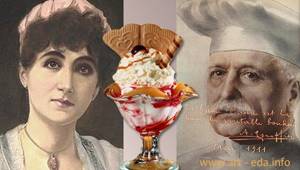
The outstanding chef’s merits also include the introduction of the conveyor method in the kitchen and the division of its staff into separate teams under the control of the chef de partie (he first used it at the Savoy Hotel). And another new one, the so-called. “Russian” way of serving dishes (service à la russe), in which the dishes are not served all at the same time, but in the order given on the menu.
*****
"Gastronomic calendar for 1867"
A true joy for gourmets of the early 19th century was the author’s publication of the “Gastronomic Calendar” by Baron Brisset. In our time, Baron Brisset is considered one of the founders of culinary journalism, but even in the Second Empire he was the same as the witty culinary explorer Grimaud de La Reniere was before him.
Brisset was born in 1813 into the family of a military commissar. During his life he was a lieutenant, organized hound hunts, was engaged in farming and buying land. And after 1850 he took up journalism. He wrote about cooking for the popular publications Le Figaro and La Liberte. He spent most of his salary in taverns, ordering dozens of dishes. We can say that he followed in the footsteps of Francois Rabelais, combining a huge appetite with gourmetism. (No wonder his close friend was Alexandre Dumas). As a consequence, his excess weight was a constant source of good-natured banter.
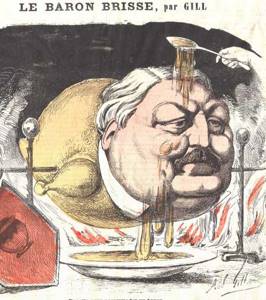
(On the cover of an 1867 magazine, the baron is being cooked on a spit. The text under the cartoon read: “A recipe fit for a baron.” And then there is a list of the exquisite ingredients of the dish “delicacy baron in its own juice”).
As an author, Brisset became famous for founding a gourmet magazine (1864), in an adapted translation called " The Dining Room, Chronic Tables ". The subheadings were no less catchy: “a journal of culinary recipe observations, supplies from literary gourmets and food masters,” etc. Just as Grimaud once did in his reviews, he published here the addresses of food suppliers and their prices. (True, his diligence was not appreciated at that time and the magazine went bankrupt). But to this day, many aphorisms about feasts and food from the text of his “La Petite Cuisine” (1870) have been preserved in France.
Gastronomic Calendar has become a permanent guide to French cuisine . It contains exactly 365 menus (according to the number of days in the year), divided by season. The connoisseur and connoisseur of French cuisine took the preparation of the calendar very seriously, and supplied the proposed menus with 700 recipes borrowed from the best practitioners of the old culinary school. And to make it easier for housewives and cooks to use the calendar, he compiled a table of contents of recipes in alphabetical order.
*****
Culinary poetry
In conclusion, I would like to mention another amazing author and his recipes for dishes in the form of blank verses. This author was the French chef Ozanne (1846-1896). Unfortunately, there is no information about his biography even on Wikipedia. Although from fragmentary information one can imagine his personality traits.
Few people already remember that Achille Ozanne was the chef of the King of Greece, but books of his “gourmet poems” are still being republished.
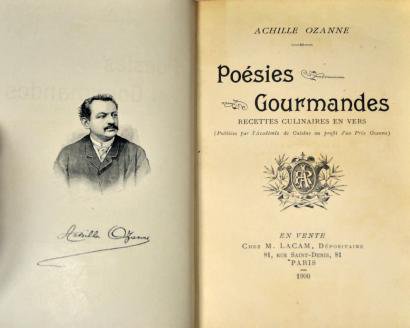
Of course, many chefs had a literary gift. This was evident in their artistic descriptions of dishes, recipes, and even ordinary “production” processes in the kitchen. Well, don’t the three types of roe deer look poetic in the definition of the great French chef Prosper Montagnier when he sublimely calls them the “Holy Trinity”. He appoints Cassoulet from Castelnaudary as "Father", from Carcassonne as "Son", and from Toulouse as "Holy Spirit". But we are talking about only three types of meat, because of which the roe deer dish takes on a different taste.
Achilles' poems to Ozanne are also directly related to food recipes. True, they rarely contain the proportions of ingredients. More often his poetry takes the form of witty culinary sketches. Of course, they did not gain the fame of the works of Brillat-Savarin or the poems of the French humorist Joseph de Berchoux. (By the way, this poet coined the word “gastronomy”, using it in his famous playful poem published in 1801).
But in his poems, Ozanne also shone with the gift of artistic imagination combined with his culinary experience. And although culinary poems did not bring much money to the author, thanks to them his name entered the annals of culinary history. Realizing that poetic seasoning gives any dish a sublime aroma, many famous chefs of Paris invited Achille Ozonnet to illustrate their cookbooks and articles with his poetry. He turned out to be a master at making humorous “recipe sketches” from real dishes and calculating simple but unexpected formulas for their preparation. It looked something like this:
To prepare a delicious stew, you first need a hare that was killed by a shot, and not one that died of fever. It should be skillfully cut into pieces. In a frying pan, combining with bacon, Fry the onion rings slowly, so that they become golden, but not dark...”
And further in the same spirit, until the final completion of the recipe. Although there were also more precise recipes, indicating the weight and quantity of its constituent products, as can be seen from the romantic lines about the king cake.
*****
One can cite dozens more outstanding works in which great originals and experts in their field described cooking and French cuisine. But even from the few examples we have given, it is obvious that each of the authors of that historical period was a bright, extraordinary personality, and their compositions, amazing in content and form, have survived to this day and are respected by modern culinary specialists.
You may also like articles
- LITERARY RECIPES: BRETON PIE WITH PRUNES
- MRS DICKENS, WHAT'S FOR DINNER?
- THE VINAIGRETTE. HISTORY AND RECIPES
- BEST ONION SOUP
- CULINARY POETRY: HEather HONEY







